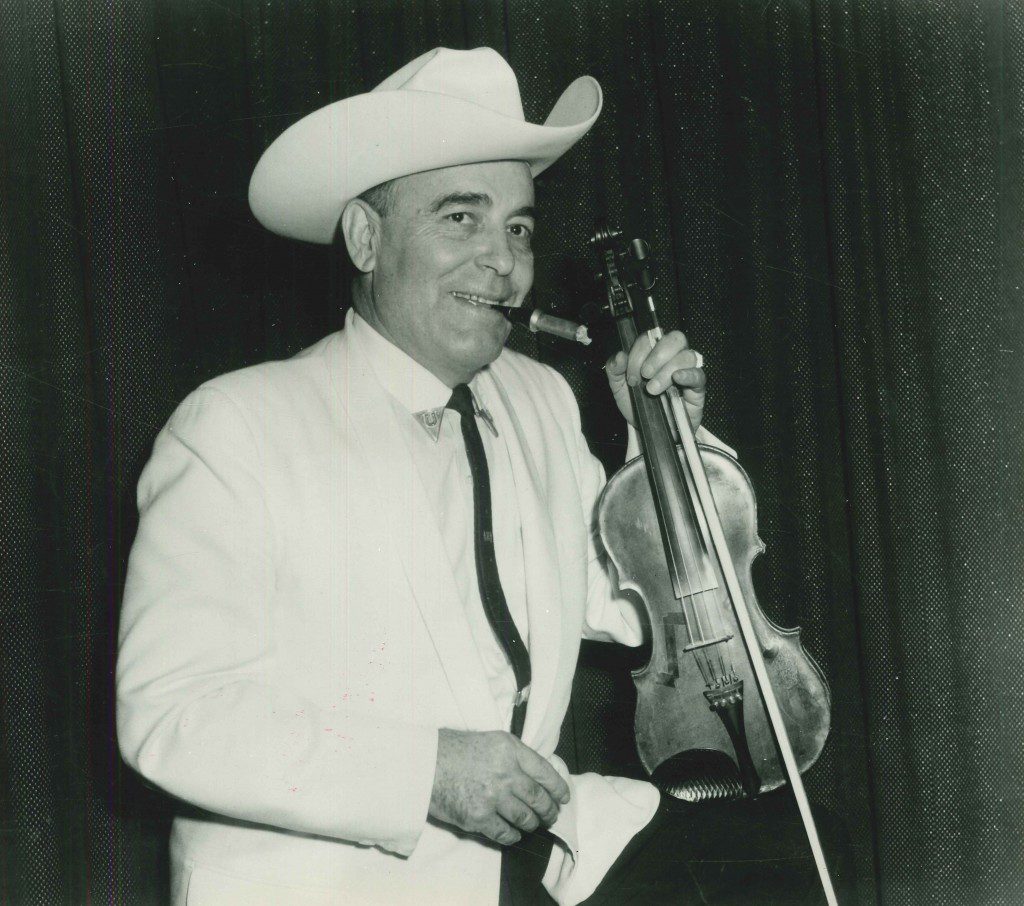
‘Good Old Oklahoma’
It was Oklahoma City that almost became the home of western swing. Like Tulsa, it had the three-legged platform necessary for launching this vibrant new music on a major scale: A powerful radio station (both WKY and KOMA fit the bill), a big dancehall (the Trianon Ballroom) and Bob Wills and the Texas Playboys – the “Texas” was added after the band crossed the Red River. And Oklahoma City was the first place the band headed to after leaving Waco in early 1934. After unsuccessfully attempting to land a slot at KOMA, which was one of several Southwestern stations hooked to a telephone-line network that carried broadcasts of the still-popular Light Crust Doughboys, the Playboys got a show on rival station WKY.
But the band had been affiliated with the station barely a week when program director Daryl McAllister called Wills and Mayo to his office.[pullquote]“I said, ‘Bob, KVOO radio is over there, and they’re a 25,000-watt station. This station we’re going to is only a 500-watt station. Let’s go see KVOO first, and we might get a chance to get on that station.’”[/pullquote]
“O’Daniel had called the manager of that station, the big shot, and told him he’d been figuring on moving his show from KOMA over to WKY,” Mayo recalled. “But as long as they had Bob Wills on, he wasn’t going to consider it any more. [O’Daniel] gave him such a talk that he thought all he had to do was kick Bob off the station and he’d have the Light Crust Doughboys show.”
The Doughboys broadcasts meant plenty of Burrus Mill advertising dollars, so there was no arguing – even though Mayo knew that O’Daniel would likely keep the program at KOMA in Oklahoma City. The band was finished at WKY before it’d hardly started.
McAllister, however, told Wills and Mayo about a brand-new station – a small outfit with the call letters KTUL – down the road in Tulsa. He put in a call to the station manager who offered to give the boys a listen.
So, on the cold and foggy morning of Feb. 11, 1934, Bob Wills, O.W. Mayo and Playboys announcer and trumpeter Everett Stover hit U.S. Highway 66 for Tulsa. And somewhere along the way, they made a decision that changed the course of music history.
According to Mayo, it went like this: “I said, ‘Bob, KVOO radio is over there, and they’re a 25,000-watt station. This station we’re going to is only a 500-watt station. Let’s go see KVOO first, and we might get a chance to get on that station.’”
Owned by Tulsa-based oil magnate William G. Skelly, KVOO (the call letters stood for Voice of Oklahoma) was what was known as a clear-channel station, which meant that its signal traveled far beyond the Tulsa area. Mayo knew it would be a major coup to call KVOO home, and all three men were delighted when station manager William B. Way agreed to put the band on at midnight. Mayo phoned back to Oklahoma City with the good news, and the rest of the Playboys lit out for the station, arriving in Tulsa around dusk.
That night, Bob Wills and the Texas Playboys made their first of what would be thousands of broadcasts from KVOO, offering a free photo to the listener writing them from the farthest distance. The clear-channel reach of the station was reflected in the winning entry, which came from Oakland, Calif.
“So they put us on in the morning,” said Mayo, “and then in the afternoon, and the letters began to come in, and they began to see what was going on.”
When Wills and KVOO connected, two of the three pieces that would make Tulsa the capital city of western swing clicked into place. The third didn’t come along for another few years, but it was foreshadowed by a benefit dance Wills and the band played on New Year’s Day 1935 for the nurses of Morningside Hospital, now Hillcrest Medical Center. It was the band’s first time to play the venue named Cain’s Academy of Dance, a place about twice the size of the second-floor hall they’d been working regularly, the Pla-Mor Ballroom (formerly at Second Street and Madison Avenue). The Academy’s namesake, Madison “Daddy” Cain, ran dance classes out of the building, although he’d suffered a stroke about the same time Wills and the Playboys moved to Oklahoma.
Making a deal with Cain and his right-hand man, Howard Turner, Mayo and Wills moved the Playboys’ regular nighttime dance engagements to Cain’s. Then, in 1937, Wills and Mayo bought out Madison Cain’s lease from the estate of Tulsa founding father Tate Brady, who’d built the hall in 1924.
Somewhere in there, Bob Wills and the Texas Playboys – who’d been regularly playing noon-hour shows over KVOO – began broadcasting from Cain’s, letting audiences in for free. The station began airing portions of the Playboys’ Thursday and Saturday night dances, and with KVOO’s broadcast pattern reaching much farther at night, hundreds of thousands of people were exposed to Wills’ music live from Cain’s.
So, thanks to a Tulsa radio station and a Tulsa ballroom, this new sound took hold across much of the nation, especially in the west and southwest. By the late 1930s, Bob Wills and the Texas Playboys were recording and touring stars, and western swing, born in Fort Worth, was growing up in Tulsa, its new hometown.
























